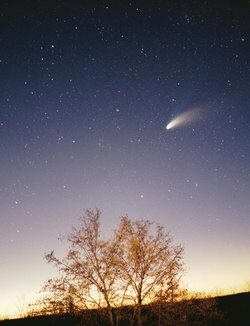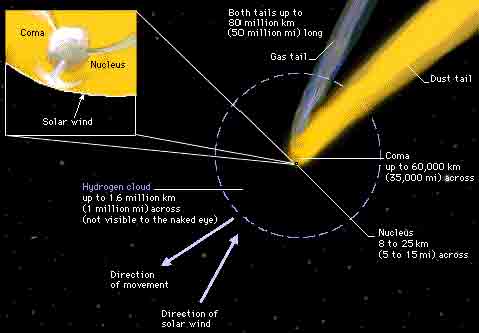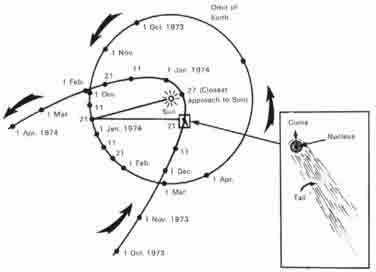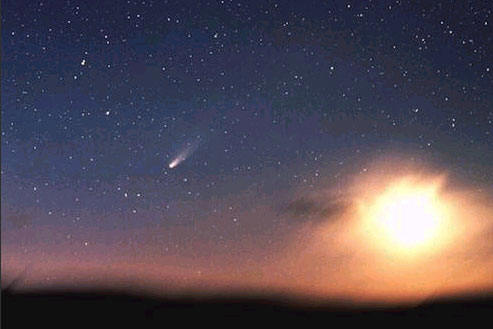|
         
> The Sun
> Mercury
> Venus
> Earth
> Mars
> Jupiter
> Saturn
> Uranus
> Neptune
> Pluto
> The 10th Planet?
> Asteroids
> Comets
> The 'Edge'
  
|
Comet (Latin, stella
cometa, “hairy star”), celestial body of nebulous appearance, revolving
round the Sun. A comet is characterized by a long, luminous tail, but only
in that part of the comet’s orbit in which it passes closest to the Sun.
A comet is a small body in the solar system that orbits the sun and (at
least occasionally) exhibits a coma (or atmosphere) and/or a tail -- both
due primarily to the effects of solar radiation upon the comet's nucleus,
which itself is a minor planet composed of rock, dust, and ices. Due to
their origins in the outer solar system and their propensity to be highly
affected by relatively close approaches to the major planets, comets'
orbits are constantly evolving. Some are moved into sun grazing orbits
that destroy the comets when they near the sun, while others are thrown
out of the solar system forever. But a bright comet is one of the surest
celestial events to capture the interest of the general public.
Comets are believed to originate in a cloud (the Oort cloud) at large
distances from the sun consisting of debris left over from the
condensation of the solar nebula; the outer edges of such nebulae are cool
enough that water exists in a solid (rather than gaseous) state.
Asteroids
originate via a different process, but very old comets which have lost all
their volatile materials may come to resemble asteroids.
Comets have fascinated people for millennia, but until 1994 no one had
ever had the chance to witness first-hand the destructive power of these
enigmatic celestial wanderers. From July 16 to 22 of that year, fragments
of Comet Shoemaker-Levy 9 smashed into Jupiter, creating a series of
spectacular fireballs in the giant planet’s atmosphere. The string of
explosions was awesome, yet the discovery that comets can wreak havoc
would not have come as a surprise to our distant ancestors.
History
Appearances of large comets were regarded as atmospheric
phenomena until 1577, when the Danish astronomer Tycho Brahe proved that
they were celestial bodies. In the 17th century the English scientist
Isaac Newton demonstrated that the movements of comets are subject to the
same laws that control the planets in their orbits. By comparing the
orbital elements of a number of earlier comets, Edmond Halley showed the
comet of 1682 to be identical with the two that had appeared in 1607 and
1531, and he successfully predicted the return of the comet, which
reappeared in 1758. The earlier appearances of Halley’s comet have now
been identified from records dating from as early as 240 bc. Halley’s
comet passed round the Sun most recently early in 1986. As it once more
headed outward, it was visited in March of that year by two
Soviet-constructed probes, Vega 1 and 2, and by another instrumented
package called Giotto, launched by the European Space Agency. Two Japanese
craft observed it from a great distance as it passed. [Top]
Composition
A comet consists of a sharply defined nucleus, looking
like a star to the naked eye, embedded in a nebulous cloud called the
coma. The American astronomer Fred L. Whipple proposed in 1949 that the
nucleus, containing practically all the mass of the comet, is a “dirty
snowball” conglomerate of ices and dust.
 |
Composition of a Comet
For most of its orbit a comet’s nucleus, which
is made of dust and ice, shows no activity; only when it approaches
the Sun do the parts visible from Earth—the coma and tails—appear.
They are caused by charged particles from the Sun (the solar wind)
heating up the nucleus until the dust and ice erupt off its surface.
Thus the tails of dust and gas always point away from the Sun in the
direction of the solar wind, even when the nucleus is moving in a
different direction. |
Evidence for the snowball theory rests on various data.
For one thing, of the observed gases and meteoric particles that are
ejected to form the coma and tails of comets, most of the gases are
fragmentary molecules, or radicals, of the most common elements in space:
hydrogen, carbon, nitrogen, and oxygen. The radicals, for example, of CH,
NH, and OH may be broken away from the stable molecules CH 4 (methane),
NH3 (ammonia), and H2O (water), which may exist as ices or as more
complex, very cold compounds in the nucleus. Another fact in support of
the snowball theory is that the best-observed comets move in orbits that
deviate slightly, but significantly, from Newtonian gravitational motion.
This provides clear evidence that the escaping gases produce a jet action,
propelling the nucleus of a comet slightly away from its otherwise
predictable path. In addition, short-period comets, observed over many
revolutions, tend to fade very slowly with time, as would be expected of
the kind of structure proposed by Whipple.
The head of a comet, including the hazy coma, may exceed the planet
Jupiter, or sometimes even the Sun, in size. The solid portion of most
comets, however, has a volume of only a few cubic kilometres. The
dust-blackened nucleus of Halley’s comet, for example, is about 15 by 8 km
(9 by 5 mi) in size. Detailed images of the nucleus of Comet Borrelly,
obtained by the NASA spacecraft Deep Space 1 in September 2001, revealed a
complex surface of mountains, valleys, faults, and fractures.
Finally, the part of a comet that is most well-known is the tail. Most
comets usually have two tails, and usually one is much brighter than the
other. The tails form as a result of the sun's solar wind - the stream of
charged particles that emanate from the sun. The solar wind dislodges gas
and dust from the comet and forces the material into very narrow (relative
to their length) tails. The tails always point away from the sun, which is
sometimes counter-intuitive. This is because even when the comet is
traveling away from the sun, the tail faces away, so the comet is, in
effect, following its tail.
The gas and dust form separate tails due to the charge of their
constituents. The dust is not highly charged, and so forms a bent tail
that slightly lags behind pointing directly away from the sun; its color
is yellow because it reflects the light of the yellow sun. The gas tail is
much more highly charged, and so the solar wind acts to funnel it much
more effectively than it does the dust cloud; its color is blue due to
molecules that make it up.
The tails can be several million miles long each, and the longest have
been observed to be over one A.U. (over 93 million miles long). Due to the
nature of how the tails form -- material being blown off of the comet -
the tails are how comets loose the bulk of their mass. The material
usually dissipates after several hundred years, but before that happens,
the material usually will continue in the orbit of the comet. If the Earth
plows through this, we see a meteor shower. [Top]
Orbital Characteristics
Comets are classified according to their orbital periods.
Short period comets have orbits of less than 200 years, while Long period
comets have longer orbits but remain gravitationally bound to the Sun.
Single-apparition comets have parabolic and hyperbolic orbits which will
cause  them to
permanently exit the solar system after one pass by the Sun. On the other
extreme, the short period Comet Encke has an orbit which never places it
farther from the Sun than Jupiter. Short-period comets are thought to
originate in the Kuiper belt, whereas the source of long-period comets is
thought to be the Oort cloud. A variety of mechanisms have been proposed
to explain why comets get perturbed into highly elliptical orbits,
including close approaches to other stars as the Sun follows its orbit
through the Milky Way Galaxy; the Sun's hypothetical companion star
Nemesis; or an unknown Planet X. them to
permanently exit the solar system after one pass by the Sun. On the other
extreme, the short period Comet Encke has an orbit which never places it
farther from the Sun than Jupiter. Short-period comets are thought to
originate in the Kuiper belt, whereas the source of long-period comets is
thought to be the Oort cloud. A variety of mechanisms have been proposed
to explain why comets get perturbed into highly elliptical orbits,
including close approaches to other stars as the Sun follows its orbit
through the Milky Way Galaxy; the Sun's hypothetical companion star
Nemesis; or an unknown Planet X.
Because of their low masses, and their elliptical orbits which frequently
take them close to the giant planets, cometary orbits are often perturbed.
Short period comets display a strong tendency for their aphelia to
coincide with a giant planet's orbital radius, with the Jupiter family of
comets being the largest, as the histogram shows. It is clear that comets
coming in from the Oort cloud often have their orbits strongly influenced
by the gravity of giant planets as a result of a close encounter. Jupiter
is the source of the greatest perturbations, being more than twice as
massive as all the other planets combined, in addition to being the
swiftest of the giant planets.
Histogram of the aphelia of the 2005 comets, showing the giant planet
comet families. The abscissa is the natural logarithm of the aphelion
expressed in AUs.Also because of gravitational interactions, a number of
periodic comets discovered in earlier decades or previous centuries are
now lost, since their orbits were never known well enough to know where to
look for their future appearances. However, occasionally a "new" comet
will be discovered and upon calculation of its orbit it turns out to be an
old "lost" comet. An example is Comet 11P/Tempel-Swift-LINEAR, which was
discovered in 1869 but became unobservable after 1908 due to perturbations
by Jupiter, and was not found again until accidentally rediscovered by
LINEAR in 2001 [Top]
Great Comets
While hundreds of tiny comets pass through the inner solar
system every year, only a very few comets make any impact on the general
public. About every decade or so, a comet will become bright enough to be
noticed by a casual observer — such comets are often designated Great
Comets. In times past, bright comets often inspired panic and hysteria in
the general population, being thought of as bad omens. More recently,
during the passage of Halley's Comet in 1910, the Earth passed through the
comet's tail, and erroneous newspaper reports inspired a fear that
cyanogen in the tail might poison millions, while the appearance of Comet
Hale-Bopp in 1997 triggered the mass suicide of the Heaven's Gate cult. To
most people, however, a great comet is simply a beautiful spectacle.
 |
Return of Halley's Comet
Halley’s Comet reappears approximately every
76 years; this photograph, taken in New Zealand in 1986, shows the
comet during its most recent approach to the Sun. Comets become
visible near the Sun because solar radiation vaporizes parts of the
icy nucleus, forming the comet’s coma and tail. |
Predicting whether a comet will become a great comet is
notoriously difficult, as many factors may cause a comet's brightness to
depart drastically from predictions. Broadly speaking, if a comet has a
large and active nucleus, will pass close to the Sun, and is not obscured
by the Sun as seen from the Earth when at its brightest, it will have a
chance of becoming a great comet. However, Comet Kohoutek in 1973
fulfilled all the criteria and was expected to become spectacular, but
failed to do so. Comet West, which appeared three years later, had much
lower expectations (perhaps because scientists were much warier of glowing
predictions after the Kohoutek fiasco), but became an extremely impressive
comet.
The late 20th century saw a lengthy gap without the appearance of any
great comets, followed by the arrival of two in quick succession — Comet
Hyakutake in 1996, followed by Hale-Bopp, which reached maximum brightness
in 1997 having been discovered two years earlier. As yet, the 21st century
has not seen the arrival of any great comets. [Top]
Further Reading
[Top] External Links
[Back] [Top] [Next] |


 them to
permanently exit the solar system after one pass by the Sun. On the other
extreme, the short period Comet Encke has an orbit which never places it
farther from the Sun than Jupiter. Short-period comets are thought to
originate in the
them to
permanently exit the solar system after one pass by the Sun. On the other
extreme, the short period Comet Encke has an orbit which never places it
farther from the Sun than Jupiter. Short-period comets are thought to
originate in the 